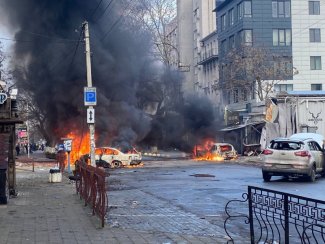Russians destroy Kherson. 306th day of the war

On 23 and 24 December, there was massive shelling of Kherson (it was attacked 41 times on Christmas Eve), which continued with less intensity (7–11 times a day) in the following days. 16 residents were killed and 64 wounded. Local authorities have once again called for evacuations – with around 200 people leaving the city daily. Defence Minister Oleksii Reznikov reported that the Ukrainian army has insufficient means to conduct effective counter-battery fire and prevent the enemy from destroying Kherson and other towns in the frontline zone. He pointed to the drama of the civilian population and once again appealed to the West to increase the supply of heavy weaponry and long-range means of destruction.
In addition to Kherson, Beryslav, Nikopol, its surroundings, and the Ochakiv area, among others, are being permanently shelled. In addition, the aggressor’s artillery and aviation continue to strike enemy army positions and facilities along the contact lines and in the border areas. Missiles fell twice on Kramatorsk and the Zaporizhzhia outskirts. The Ukrainians responded with fire, mainly in Donbas and Zaporizhzhia Oblast.
Russian forces broke through enemy defences northeast of Bakhmut (in the Yakovlivka area) and led an advance towards the Bakhmut–Siversk railway line and road, which was halted near Rozdolivka. Fighting continued in the eastern part of Bakhmut, where Ukrainian reinforcements had reached, as well as on the outskirts of the town and south of the town, where the defenders repulsed another attack towards Kostiantynivka. The invaders have moved to offensive operations towards Lyman (they are being held back on the border of the Luhansk and Donetsk oblasts) and have launched further unsuccessful attacks west of Horlivka and north and southwest of Avdiivka. West of Donetsk, Marinka remains the arena of the heaviest clashes. Aggressor forces have activated offensive operations northeast of Kupiansk and on the border of the Kharkiv and Luhansk oblasts. Ukrainian troops went on the defensive – attempting counter-attacks south of Vuhledar and sabotage and reconnaissance operations towards Kreminna.
On 26 December, Russian sources reported another attack on the Engels strategic bombers airbase (more than 600km from the border), allegedly carried out by Ukrainians using a drone. The Russian defence ministry reported that the falling debris of the downed machine killed three soldiers. Another act of diversion was also reported from Melitopol. Kyiv confirmed the dismantling in Russia’s Bryansk Oblast of a Ukrainian sabotage and reconnaissance group responsible for attacks on infrastructure there.
Ukraine received a thirteenth Bergepanzer 2 armoured recovery vehicle from Germany. The first group of Ukrainian military mechanics completed field service training in Lithuania for German PzH 2000 howitzers. In 2023 Vilnius plans to provide Kyiv with nearly €40 million in military aid. The eleventh package of military support – worth €28.8 million – was provided by Finland. US Secretary of the Army Christine Wormuth announced that the current capacity of the US arms industry allows for the production of 14,000 artillery shells per month, while the Ukrainian army fires that many in two days. Washington is working to increase its production capacity and convince European allies to transfer their munitions stocks to Kyiv. Foreign Minister Dmytro Kuleba announced on 26 December that the US had developed a plan for the accelerated deployment of Patriot missile systems in Ukraine. This is to occur within six months after local personnel have been trained.
A day later, British military intelligence confirmed that some units of the 1st Guards Tank Army of the Western Military District (MD) had been diverted to Belarus but did not have the support to put them on combat alert. According to the British, a key factor limiting the Russian army’s offensive potential is the lack of sufficient ammunition reserves and fire support to carry out operations along the front line. Earlier, the head of Ukrainian military intelligence (HUR) Kyrylo Budanov stated that enemy troops are not forming a strike grouping in Belarus and that soldiers trained there are then being directed to fight in the Donbas. The troop movements near the border are meant to pose as preparations for an offensive to tie down significant Ukrainian forces.
According to an HUR report – fourth since 24 February – Lieutenant General Yevgeny Nikiforov, formerly deputy head of the Eastern MD, has become the new commander of the Western MD. Nikiforov’s promotion, who has experience commanding a grouping in Syria, was expected to be influenced by the support of Sergey Surovikin, who is commanding the operation in Ukraine. The frequent personnel changes are said to result from ineptness in offensive operations. They may also signal a difference of opinion among the generals on how to conduct the military operation.
The Security Service of Ukraine confirmed that more than 1,200 people spreading Russian disinformation had been unmasked since the start of the aggression. The activity of 45 large bot farms, using over 2 million fake accounts and almost 500 pro-Russian channels on YouTube, with 15 million subscribers, has been blocked. According to the report, the number of cyber-attacks has increased from almost 800 in 2020 and 1,400 in 2021 to more than 4,000 since the beginning of 2022. The enemy is said to be carrying out more than 10 of them per day on the information systems of energy, logistics and military facilities, as well as on databases and information resources of the state administration. The high effectiveness of Ukrainian operations in the digital space is ensured by the participation of IT specialists forming an informal ‘digital territorial defence’.
Commentary
- The systematic destruction of Kherson can be seen as Moscow’s challenge to the West. The resources provided to Kyiv necessary for defence do not only include air defence equipment – the states that provide military support to Ukraine must constantly increase their production of artillery munitions. Russia runs the risk of a clash of economic potentials in which it would be the decidedly weaker party. Nevertheless, it hopes that Western societies will not accept the rising costs of supporting Ukraine and will force their governments to reduce their aid and thus deprive Kyiv of defensive means.
- In recent weeks, Ukrainian forces have turned to defence and lost the initiative they captured in early September with an offensive in the Kharkiv Oblast (their offensive operations in the Svatove and Kreminna directions were halted in late November and early December). This state of affairs was due to the exhaustion of the defenders, who did not receive sufficient support in the autumn in the form of equipment and ammunition to continue a wider offensive. The enemy’s consolidation and strengthening of the defences also contributed to its deceleration.
- The situation on the front is a stalemate – the Russians are the attacking side but have not accumulated sufficient resources to carry out another offensive. They are unable to develop progress despite breaking through the enemy’s defensive positions, which has occurred several times in recent weeks. Both the Russians and Ukrainians had expanded their defences. Therefore, neither a Russian offensive (like at the beginning of the war) or the Ukrainian offensive (like in September) is likely to occur, as they were both enabled by the weakness of the enemy’s defence. A transition to offensive action will be possible if either side gains and maintains a significant advantage over the enemy in at least one of the main directions.




